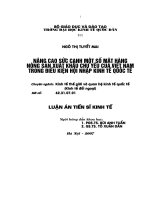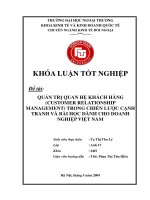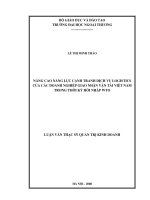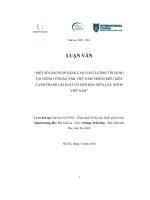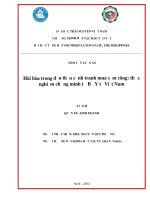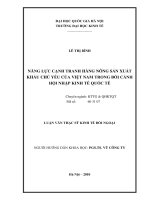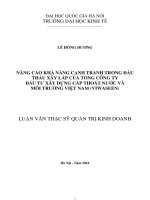Hài hòa trong đấu thầu cạnh tranh mua sắm công thực nghiệm chứng minh từ bộ y tế việt nam
Bạn đang xem bản rút gọn của tài liệu. Xem và tải ngay bản đầy đủ của tài liệu tại đây (864.1 KB, 116 trang )
A RESEARCH PAPER PRESENTED TO THE FACULTY OF THE GRADUATE SCHOOL SOUTHERN LUZON
STATE UNIVERSITY IN COLLABORATION WITH THAI NGUYEN UNIVERSITY
..
ThAi nguyen University
Socialist Republic of Vietnam
Southern luzon STATE University
Republic of Philippines
HARMONIZATION OF PUBLIC COMPETITIVE TENDERING :
EMPIRICAL EVIDENCE FROM THE MINISTRY
OF HEALTH IN VIETNAM
Advisor
:
Name of Student
Dr. Alice T. Valerio
:
NGUYEN DUY PHUONG
English Name :
NOAH
Date of Birth :
13-12-1974
Course
SLSU-DBA1
:
Hanoi May, 2013
i
A RESEARCH PAPER PRESENTED TO THE FACULTY OF THE GRADUATE SCHOOL SOUTHERN LUZON
STATE UNIVERSITY IN COLLABORATION WITH THAI NGUYEN UNIVERSITY
HARMONIZATION OF PUBLIC COMPETITIVE TENDERING :
EMPIRICAL EVIDENCE FROM THE MINISTRY OF
HEALTH IN VIETNAM
A Dissertation
Presented to the Faculty of the
Graduate School of Southern Luzon State University
in Collaboration With Thai Nguyen University
In Partial Fulfilment
of the Requirements for the Degree
Doctor in Business Administration
NGUYEN DUY PHUONG
May 2013
ii
A RESEARCH PAPER PRESENTED TO THE FACULTY OF THE GRADUATE SCHOOL SOUTHERN LUZON
STATE UNIVERSITY IN COLLABORATION WITH THAI NGUYEN UNIVERSITY
ACKNOWLEDGMENT
I would like to express my gratitude to Dr. Alice T. Valerio for being an outstanding
advisor and excellent professor. Her constant encouragement, support, and invaluable
suggestions made this work successful. She has been everything that one could want in an
advisor. I would like to thank her for providing me ideas on the research methodology and
valuable insights on public procurement system and international bidding implementation
issues.
I am deeply indebted to my committee member, Dr. Lee Kari Ling for her time and
effort in reviewing this work. Also, I would like to thank all the lecturers of DBA1 course for
helping me to complete this thesis which I have been their student for three years.
I would like to acknowledge my best friends in the DBA 1 class for reviewing my
thesis and providing valuable feedback. I am grateful to Mr. Ngo Anh Cuong and Mrs. To
Ngoc Lan for their help and valuable advice, and for being great friends throughout my
program stint.
I am deeply and forever indebted to my family for their love, support, and
encouragement throughout my entire life. I would like to thank my wife, Bui Thi Nga, who
has provided a tremendous amount of love and support throughout this study. On a final note
with love are for my children, my five-year old daughter and three-year old son!
iii
A RESEARCH PAPER PRESENTED TO THE FACULTY OF THE GRADUATE SCHOOL SOUTHERN LUZON
STATE UNIVERSITY IN COLLABORATION WITH THAI NGUYEN UNIVERSITY
DEED OF DECLARATION
I, Nguyen Duy Phuong (English name: Noah), hereby submit my thesis for oral
examination,
entitled
“HARMONIZATION
OF
PUBLIC
COMPETITIVE
TENDERING: EMPIRICAL EVIDENCE FROM THE MINISTRY OF HEALTH IN
VIETNAM”, truthfully declare that the said paper is a product of my original research
investigation.
Signed this …………………….2013 at Thai Nguyen University
NGUYEN DUY PHUONG
DBA Candidate
iv
A RESEARCH PAPER PRESENTED TO THE FACULTY OF THE GRADUATE SCHOOL SOUTHERN LUZON
STATE UNIVERSITY IN COLLABORATION WITH THAI NGUYEN UNIVERSITY
TABLE OF CONTENTS
Page
ACKNOWLEDGMENT........................................................................................................iii
DEED OF DECLARATION ................................................................................................. iv
TABLE OF CONTENTS........................................................................................................ v
LIST OF TABLES.................................................................................................................. ix
LIST OF FIGURES................................................................................................................. x
LIST OF ABBREVIATIONS................................................................................................ xi
APPROVAL SHEET ............................................................................................................xii
ABSTRACT ..........................................................................................................................xiii
CHAPTER I ............................................................................................................................. 1
INTRODUCTION ................................................................................................................... 1
1.
Background of the Study............................................................................................... 1
2.
Statement of the Problem .............................................................................................. 3
3.
Objectives ....................................................................................................................... 5
4.
Hypotheses of the Study. ............................................................................................... 6
5.
Significance of the Study............................................................................................... 6
6.
Scope and Limitations of the Study .............................................................................. 7
7.
Definition of Terms ....................................................................................................... 9
CHAPTER II ......................................................................................................................... 13
REVIEW OF RELATED LITERATURE .......................................................................... 13
1.
Systems Theory ............................................................................................................ 13
2.
Administrative Theory ................................................................................................. 14
v
A RESEARCH PAPER PRESENTED TO THE FACULTY OF THE GRADUATE SCHOOL SOUTHERN LUZON
STATE UNIVERSITY IN COLLABORATION WITH THAI NGUYEN UNIVERSITY
3.
Procurement Legislation and Studies......................................................................... 15
4.
Procurement Administrative Theories and Studies.................................................... 20
5.
Legislation of Vietnam and International Community for Procurement ................. 23
6.
Conceptual and Theoretical framework ..................................................................... 24
CHAPTER III........................................................................................................................ 29
RESEARCH METHODOLOGY......................................................................................... 29
1.
Research Design .......................................................................................................... 29
2.
Time and Place of the Study ....................................................................................... 30
3.
Sampling Procedures................................................................................................... 31
4.
Data Collection ............................................................................................................ 31
5.
Research Instrument ................................................................................................... 34
6.
Statistical Treatment.................................................................................................... 36
7.
Methods of Analysis ................................................................................................... 40
CHAPTER IV ........................................................................................................................ 42
RESULTS AND DISCUSSION............................................................................................ 42
1.
Provisions in ILT and LLT in Vietnam ...................................................................... 42
2.
Public Procurement Activities in MOH...................................................................... 56
3.
Procurement and Bidding Practices in Terms of Transparency and Openness
Measures ............................................................................................................................. 62
4.
Formulation of efficient public procurement............................................................. 64
CHAPTER V.......................................................................................................................... 74
CONCLUSION AND RECOMMENDATIONS ................................................................ 74
1.
Summary ...................................................................................................................... 74
2.
Conclusion ................................................................................................................... 75
vi
A RESEARCH PAPER PRESENTED TO THE FACULTY OF THE GRADUATE SCHOOL SOUTHERN LUZON
STATE UNIVERSITY IN COLLABORATION WITH THAI NGUYEN UNIVERSITY
3.
Recommendations........................................................................................................ 76
REFERENCES ...................................................................................................................... 98
vii
A RESEARCH PAPER PRESENTED TO THE FACULTY OF THE GRADUATE SCHOOL SOUTHERN LUZON
STATE UNIVERSITY IN COLLABORATION WITH THAI NGUYEN UNIVERSITY
APPENDIES
Appendix
Page
1. LETTER REQUEST FOR THE CONDUCT OF THE SURVEY .....................................80
2. SURVEY QUESTIONNAIRE............................................................................................ 82
3. CURRICULUM VITAE .....................................................................................................89
4. BUDGET REVENUES AND EXPENDITURES .............................................................. 95
5. TOTAL GOVERNMENT EXPENDITURE , 1990-2010 ..................................................95
6. CORRUPTION PERCEPTIONS INDEX...........................................................................96
7. MINISTRY OF HEALTH STRUCTURE ..........................................................................97
viii
A RESEARCH PAPER PRESENTED TO THE FACULTY OF THE GRADUATE SCHOOL SOUTHERN LUZON
STATE UNIVERSITY IN COLLABORATION WITH THAI NGUYEN UNIVERSITY
LIST OF TABLES
Table
Page
1. Factors affecting the harmonizing ....................................................................................... 35
2. Likert scale summated rating for openness and transparency procurement....................... 41
3. Discrepancy in public procurement.....................................................................................43
4. Department of Administrators............................................................................................. 58
5. Testing result of reliable of Model ...................................................................................... 65
6. Description of Mean and Standard Deviation .....................................................................66
7. Post Hoc Tests openness and transparency procurement ....................................................67
8. Model Summary Option ......................................................................................................69
9. ANOVA F-Test ...................................................................................................................69
10. T-test coefficient................................................................................................................70
11. Linear regression for 02 removed variables ......................................................................72
12. T-test for Coefficient and Multicollinearity ......................................................................72
ix
A RESEARCH PAPER PRESENTED TO THE FACULTY OF THE GRADUATE SCHOOL SOUTHERN LUZON
STATE UNIVERSITY IN COLLABORATION WITH THAI NGUYEN UNIVERSITY
LIST OF FIGURES
Figure
Page
1. Conceptual framework of the study ....................................................................................27
2. Data collection procedure....................................................................................................33
3. Distribution of respondents by position in the MOH .......................................................... 56
4. Distribution of age of respondents ...................................................................................57
5. Distribution of total working years of the respondents .....................................................58
6. Distribution of the respondents by department ...................................................................59
7. Frequency of submitting bidding documents under LCB ...................................................62
8. Frequency of applying transparency level...........................................................................63
9. Frequency of applying the most opening purchase method ................................................64
x
A RESEARCH PAPER PRESENTED TO THE FACULTY OF THE GRADUATE SCHOOL SOUTHERN LUZON
STATE UNIVERSITY IN COLLABORATION WITH THAI NGUYEN UNIVERSITY
LIST OF ABBREVIATIONS
ADB
Asian Development Bank
GOV
Government of Vietnam
ICB
International competitive bidding
ILT
International Law on Tendering
JICA
Japan International Cooperation Agency
LCB
Local competitive bidding
LLT
Local Law on Tendering LLT
PMU
Project Management Unit
PPC
Provincial People Committee
WB
World Bank
xi
A RESEARCH PAPER PRESENTED TO THE FACULTY OF THE GRADUATE SCHOOL SOUTHERN LUZON
STATE UNIVERSITY IN COLLABORATION WITH THAI NGUYEN UNIVERSITY
APPROVAL SHEET
This
thesis,
entitled
“HARMONIZATION
OF
PUBLIC
COMPETITIVE
TENDERING:EMPIRICAL EVIDENCE FROM THE MINISTRY OF HEALTH IN
VIETNAM”, prepared and submitted by Nguyen Duy Phuong in partial fulfillment of the
requirements for the degree of Doctor in Business Administration, has been examined and
recommended for acceptance and approval for FINAL EXAMINATION.
ALICE T. VALERIO, PhD
Adviser
Approved by the Committee on Oral Examination with a grade of PASSED on ….
2013
Dr………………………..…………………..
Member
Dr………………………..…………………..
Member
Dr………………………..…………………..
Member
Dr………………………..…………………..
Chairman
Accepted in partial fulfillment of the requirements for the degree of Doctor in Business
Administration.
THAI NGUYEN UNIVERSITY
Dean
SOUTHERN LUZON STATE UNIVERSITY
Dean
xii
A RESEARCH PAPER PRESENTED TO THE FACULTY OF THE GRADUATE SCHOOL SOUTHERN LUZON
STATE UNIVERSITY IN COLLABORATION WITH THAI NGUYEN UNIVERSITY
ABSTRACT
This study aimed to describe the common and the unique provisions in the
International Law on Tendering (ILT) and Local Law on Tendering (LLT) in Vietnam to
determine how procurement and bidding are being done in the Ministry of Health as
measured in terms of openness and transparency; to analyze how can the ILT and the LLT
be harmonized in the Ministry of Health using transparency and openness as factors of
harmonization; and to formulate some recommendations to have a more effective public
procurement system.
In order to find out best procuring method, the comparative research design is
used to study of differences and similarities between of international organization more
specifically, it involves study of the different legal systems in existence in Vietnam,
including Commercial Law, Investment Law and Administration Law. The secondary data
were obtained from 02 legal regulation system (Vietnam Law and at least 03 International
organization’ regulation) which are up to date. The primary data is from respondents
selected using the convenience sampling method where accessibility and cooperation of
administrators were the major considerations in all 63 provinces through District Health
Service Department. The research is mainly done by the method of data collection through
questionnaires and process the data collected.
After using statistic tool, the Author defined a efficient model which should
be applied in Vietnam. Preliminary results indicate there is one procuring method that meet
both Vietnam Law on tendering and International procuring regulations. It is International
Competitive Bidding (ICB) in which the sphere of openness as well as of transparency is the
xiii
A RESEARCH PAPER PRESENTED TO THE FACULTY OF THE GRADUATE SCHOOL SOUTHERN LUZON
STATE UNIVERSITY IN COLLABORATION WITH THAI NGUYEN UNIVERSITY
best. Through ICB procuring method, the public invest is avoid of corruption. On other
hand, it is best way to able to by highest quality products at the lowest price. Finally the
Author concluded by indicating the best of procurement method which is harmonizing the
two procurement system laws and regulations in Vietnam and suggests to Governmental
Agencies and Project Management Unit major measures of how to procuring efficiently
them.
xiv
CHAPTER I
INTRODUCTION
1. Background of the Study
Public procurement management occupies an important position in the national project
administration because its importance is evident both in practice and in the theory literature.
Above 40 years ago, Phillip Cooper (1980) noted this when he stated that public
administration should pay attention to the importance of procurement. In describing public
procurement as a critical administrative activity, many other famous scholars acknowledged
its importance, too. In fact, Vietnam Government spends a lot of money, despite signs of
modest declines in recent years. Government's collective purchasing still accounts for nearly
one-third of the nation's Gross Domestic Product (Appendix 4). Procurement is the purchase
of goods and services by public and private enterprises. Efficiency in procurement has long
been recognized as a way to obtaining the desired goods or services at the lowest price or,
more generally, at the best “value for capital”. The most common practices of procurement
involve some forms of tenders and it is believed that, under these, efficient procurement
outcomes can usually be achieved in situations where there are enough firms in the
procurement market to sustain reasonable competition. In cases with a reduced number of
firms, more sophisticated arrangements are necessary to prevent practices such as collusion,
bid-rigging, fraud and corruption, which hinder the achievement of efficient outcomes. Public
procurers also face the additional challenge of preventing political favoritism where contracts
are allocated according to loyalty or support rather than on the grounds of efficiency1.
Public investment in Vietnam includes all investments the government and private
business sectors are undertaking which include (a) Investment from the budget (allocated to
the Ministries, and distributed to local); (b) Investing in programs targeted support; (c)
1
International investment credit (loans of international organizations); and (d) Investment of
the State Owned Enterprise (SOEs). In a period of 10 years, the State of Vietnam has
implemented fiscal policy that caused a continued increase in revenues but has resulted also in
increase in public spending. Budget revenues have increased from 20.5 percent of GDP in
2000 to over 28 percent from 2006 to 2008. Expenditures also increased respectively from
24.7 percent in 2000 to over 31 percent in 2005, and has reached nearly 35 percent in 2007
(Appendix 4).
The public procurement accounts for a large percentage of total social investment
budget and has made positive contribution to the investment of Vietnam Government.
However, investment efficiency has been low. Investment has been scattered, hence,
investment is wasted. The causes to this situation include poor management, irrational
investment, lack of investment in industries with large impact on economic restructuring, and
insufficient investment in key programs. Low investment efficiency is also attributed to local
interests, lack of transparency, and poor coordination among branches and levels. Inefficient
public investment and poor investment management have not only resulted in social
investment inefficiency but also rendered bad consequences to the economy of Vietnam,
putting pressure on inflation, causing macro-imbalance, and limiting competitiveness and
quality of the integrating economy. To improve public investment quality, one of the
important principles should be to strictly implement open broad bidding of public investments
or procurement to all economic sectors and conduct regular monitoring and supervision in
public procurement2.
By international comparison, in 2010, the total spending in Vietnam accounted
to 30.7 percent of the GDP,a higher rate compared to other countries in East Asia and
Southeast Asia. This amount, which is being reported in the current financial statistics of
Vietnam, does not include government bonds and Official Development Assistance (called as
2
ODA) funds. Thus, the State of Vietnam spends a large proportion of the wealth of society,
compared with the rest of the countries in the Region. As observed, the share of total
spending to total GDP in Vietnam
has been increasing
while in many countries, the
proportion of expenditure to GDP is relatively stable as shown in Appendix 5.
This study relating to public procurement practices has developed along the organizing
of procurement processes and the effects of different procurement methods or practices. This
recognizes several tools and strategies for its effective implementation. Several aspects have
been investigated such as the type of tendering, usefulness of open procedures, the impact of
transparency purchases which is considered including a quality component or mechanisms
for preventing corruption. These aspects have been incorporated into the laws and regulations
and this study has estimated the effects of such procurement practices in its models.
2. Statement of the Problem
Public procurement is a very important instrument used for allocation of a major part
of public expenditures of a State. Because of its importance, guarantees of a transparent, open,
and specified system of public procurement should exist in every country. However, the
reality in the Asian countries is different. A number of purchases are not open and therefore
funding allocation is not transparent and possibly also not effective.
As a developing country and as a member of ASEAN, Vietnam has been investing so
much on economic infrastructure, social human resource development, and environmental
protection3
The government has been borrowing a significant amount from the foreign
sources as well as receiving aids outside of official development assistance (ODA) to focus on
investment projects that have been committed with the donors including procurement
regulations such as the World Bank (WB), Asian Development Bank (ADB), and The Japan
International Cooperation Agency (JICA). The effectiveness of these projects depends in no
3
small measure on the skills and qualifications of those who administer them. In Vietnam, up to
now, project administrators wishing to improve their understanding of and skills in
administration could find little of direct relevance to their field in the administrative literature.
Beside, the corruption is a serious problem which can be attributed to lack of procurement
administration (Appendix 6). The core relates to perceptions of the degree of corruption as
seen by business people and country analysts, ranging from 10 (highly clean) to 0 (highly
corrupt). The Appendix No. 6 shows that public investment of the Vietnam Government is at
high rate with ranking 120/180 economies (in 2009) and 116/178 economies (in 2010).
Administers get illegal benefit from the gaps and differences between Vietnam Law
and international regulation related to project management, especially in procurement
procedure management, because Project Management Units (PMUs) do not know what law
system should be applied in a specified case of procurement. All the tenders are placed and
implemented in Vietnam so if PMUs applied Vietnamese law, the procurements are not
funded by the international donors. Otherwise, these tenders will not be able to get approval
from centralized agencies (ex. the Ministry of Plan and Investment – MPI) when the PMUs
submitted tendering plans resulting in the choice of contractor.
Most handbooks or guidelines of WB, ADB, and JICA are written in English, hence,
many officers in the provincial PMUs find difficulty to understand the guidelines. More often
than not, it made confusions to the PMUs, Executing Agency, Ministries and other relevant
agencies, especially on the donors’ guidelines and rules procurement. Beside that there is
difference between regulation of the donors and Vietnamese regulations on ODA management
(WB, IMF, EC, JICA, ADB, SIDA…), it makes administers and PMUs face difficulties and
confusions in organizing and implementing procurement procedures. The PMUs do not
understand which is better if they applied one of two laws and regulation systems.
4
In general, all investors wish transparency and openness procurement. However, it is
just fair or consistent with this donor’s regulation but it is not accepted in other law system.
Lack of awareness or insufficient understanding of the donors’ procurement guidelines by
PMUs and Executing Agencies shall cause the inefficient investment. This study, therefore,
shall seek answers to the following questions:
1.
What are the common and the unique provisions in the International Law on
Tendering (ILT) and Local Law on Tendering (LLT) in Vietnam?
2.
How are procurement and bidding being done in the Ministry of Health as
measured in terms of openness and transparency?
3.
How can the ILT and the LLT be harmonized in the Ministry of Health using
transparency and openness as factors of harmonization?
4.
What changes on LLT can be recommended to make the procurement system
be effective?
3.
Objectives
In general, this study assessed the transparency and openness in procuring management
in Vietnam. Specifically, this study aimed to compare the Vietnamese Laws and International
Regulations in Procurement. The thesis shall focus on following objectives:
1. To describe the common and the unique provisions in the International
Law on Tendering (ILT) and Local Law on Tendering (LLT) in Vietnam;
2. To determine how procurement and bidding are being done in the
Ministry of Health as measured in terms of openness and transparency;
3. To analyze how can the ILT and the LLT be harmonized in the Ministry
of Health using transparency and openness as factors of harmonization;
and
4. To formulate the best method to make the procurement system be more
5
effective.
4.
Hypotheses of the Study.
It was assumed that higher transparency and openness is the better preconditions for a
good procurement, competition in tendering, and for a better proportion between the lower
price and higher quality resulting in the effectiveness of tendering.
It was hypothesized that openness and transparency are significantly affecting
harmonization in ILT and LLT in the Ministry of Health. The harmonizing indicator is related
to transparency level and openness level in public procurement. The openness and
transparency are the tools which support control of the public procurement by the public, and
thus they possibly decrease possibilities for corruption activities. Openness is regarded as a
possibility of individual stakeholders to participate in the public procurement process.
Transparency means both active and passive publishing of information. The passive
publishing of information by purchasers upon request is made under Vietnam Law and
International regulation. An active publishing of information occurs when the proper
purchaser publishes selected information, whether in an official international journal, own
websites, or official announcements. The higher the transparency and openness is the more
effective the procurement and the bidding competition4.
5.
Significance of the Study
In general, a good procurement practice has a beneficial effect on procurement
outcomes. In terms of transparency, procuring via international competitive bidding is most
beneficial as it is associated with openness procurement. On the other hand, it is the best way
to harmonize between two legislation systems of Vietnam and International organizations.
The openness procedure is the most effective in attracting more bidders through
publishing of Tender Invitation, Planning Price, Valuating Criteria and Award Price. The
results of this study will show the positive and significant effects of procurement disciplines
6
on openness and transparency. In practice, there is a best way of procurement for harmonizing
between two different law systems. It is international competitive bidding which is appraised
in terms of its effect on the procurement market especially at the Ministry of Health of
Vietnam.
This study will benefit the government, PMUs, bidders, and other researchers. The
government can amend the law to remove the gaps of discrepancy between its legislative
system and international donor’s regulation related to procurement procedure. As a result,
there are more and more financial support for developing programs in Vietnam. On the other
hand, these donors shall get confidence that their funds are using efficiently. Besides that, all
available bidders will have equal opportunity to offer their best quality products at lowest
price in a competitive market. Consequently, the Vietnamese people shall have chance to
increase their living standard through using high quality service or goods which were procured
by their government. It can be an interesting instrument to investigate, characterize and
monitor the procurement practices across other Ministries of whole Vietnam Government'
public investment.
It provides a model which can be used to investigate the current
procurement practices in Vietnam, the compliance with two Law and regulation systems. The
public procurement market is taking great ratio in Vietnam and all these issues are worth
investigating in order to appraise the effect of competition in procurement in the
international market.
6. Scope and Limitations of the Study
The conceptual framework of procurement regulation identifies a relationship between
improving procurement legislative regulation and procurement method chosen. In doing so, it
implicitly recognizes that markets are not perfectly competitive and that there is opportunity
for improving procurement outcomes. This study was not able to identify the source of
changes in procurement disciplines. This will become important in interpreting the results
7
because, although we can see the effects of different procurement tools, the author cannot
disentangle the effects strictly derived from the compliance with the domestic laws and
international regulation, as some of the measures envisaged are voluntary.
It is also worth noticing that the analysis is not a comparison between regulated and
non- regulated tenders. As by definition, all the records included in the analysis are covered by
the present laws. The practice is therefore useful to compare different degrees of openness, all
of which are envisaged under the domestic laws and international regulation. In doing so, and
because of limitations of the data, this study focused on the benefits which are quantifiable,
and this implies looking at the differences in two legislation systems (domestic and
international). There may be other intangible benefits related to increases in quality, better
tailored services, or innovative solutions which are not recorded in the data and hence are not
quantifiable in this study.
Despite the many books devoted to the art of administration, generally, there have been
few descriptions of administrative concepts related to public procurement administration
specifically to health projects through International Competitive Bidding (ICB) method. So
this study has not been able to identify the source of changes in procurement regulation and
laws. The analysis is not a comparison between regulated and non-regulated tenders. Because
of limitations of the data, this study was focused only on the benefits which are qualitative and
this implies looking at the differences in international procurement regulation and Vietnam
procurement law. There may be other intangible benefits related to increases in quality, better
tailored services, or innovative solutions which are not recorded in the data and, hence, are not
made in this study.
Research shall be designed to get data from all provinces of Vietnam for latest five
years which is normal period of implementing a project. This period of time is suitable to time
schedule of almost public investment projects in Vietnam. It is a period of time which the
8
Vietnam Assembly approves new law codes or amending out of date law codes.
Thesis is including but not limited to procurement policy, procurement strategic
planning and scheduling, contract formation, contract administration, evaluation, and
procurement methods and techniques; substantive areas such as government procurement laws
and regulations. The principles outlined in this thesis study in competitive procurement of
goods financed in whole of in part from the proceeds of an Official Development Assistance
(ODA) loans from International organizations, Governments or Special Funds.
7. Definition of Terms
To provide a clear understanding of some of the terms that were used in this study, the
following were theoretically and operationally defined:
Effective Procurement refers to offering a high level of transparency, accountability and
value for money in the application of a procurement budget.
Legislation Harmonization refers to the process of creating common standards across the
competitive market aimed to create consistency of laws, regulations, standards
and practices, so that the same rules will apply to businesses.
Harmonizing procurement law is aggregated procurement in which some procuring
methods could harmonize at least two law systems
International competitive bidding means the process of selection of a contractor who
satisfies the requirements of the party calling for tenders, in which both foreign
and domestic bidder participate.
International law on Tendering refers to all international regulations of international
donors under their guidelines or handbooks for tendering activities in order to
select contractors for provision of consultancy services, for procurement of
goods, and for construction and installation for tender packages.
9
International regulations are guidelines of international organizations which are used to
inform those carrying out a project that is financed in whole or in part by a loan
from them. (These International organizations financed grant, or these
International organizations administered funds of the policies that govern the
procurement of goods, works, and services (other than consultant services)
required for the project. The financing agreement governs the legal
relationships between the Vietnam’s Government and this Organization, and
the Guidelines are made applicable to procurement of goods and works for the
project, as provided in the agreement. The rights and obligations of Vietnam’s
Government and the providers of goods and works for the project are governed
by the bidding documents, and by the contracts signed by the borrower with the
providers of goods and works, and not by these Guidelines or the financing
agreements. No party other than the parties to the financing agreement shall
derive any rights there from or have any claim to the proceeds of the financing)
Local competitive bidding refers to the process of selection of a contractor who satisfies
the requirements of the party calling for tenders, in which domestic tenderers
participate.
Local Law on tendering is a law that regulates tendering activities in order to select
contractors for provision of consultancy services, for procurement of goods, and
for construction and installation for tender packages belonging to the following
projects. This includes all Vietnamese legal documents issued by the Assembly
and Government Pursuant to the 1992 Constitution of the Socialist Republic of
Vietnam as amended by Resolution 51-2001-QH10 passed by Legislature X of
the National Assembly at its 10th Session on 25 December 200. This Law
10
Openness procurement means that, given the use of public funds, public procurement
opportunities should be open to all international qualified bidders and the
public should have access to information pertaining to public procurement.
There are also some procurement methods, such as direct/ selecting purchase,
that limit the availability of the solicitation document to bidders meeting certain
qualifications. The request for price quotations (or shopping) and direct
contracting (sole source) also present certain limitations on competition.
Public procurement is including all Investment and development projects which are
projects financed by the State as to 30 per cent or more. These projects are
required using public procurement which are implemented by a Project
Management Unit (call as PMU). At the Ministry of Health, each province is a
separated provincial PMU to perform all stages of procurement.
Procurement means the process of selecting a contractor who satisfies the requirements
set by the party calling for tenders in order to implement a tender package
belonging to a project stipulated in article 1 of Vietnamese Law on Tendering,
on the basis of ensuring competitiveness, fairness, transparency and economic
efficiency.
Project refers to a set of proposals for implementing a part or the whole of works aimed
at achieving an objective or requirement within a specified period of time and
based on a specified financing source.
Transparency procurement refers to both active and passive publishing of information
which includes a Prior Information Notice and Publish target (lowest-highest)
price of bidding package in bidding document together with Publish Evaluating
Bidding method to classify bidder in bidding document. It contains records
11
